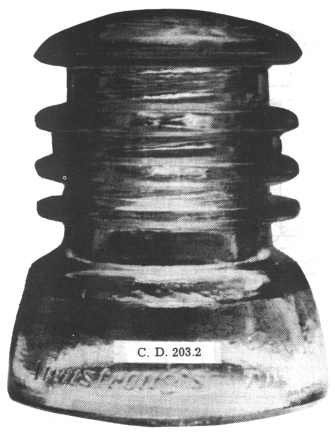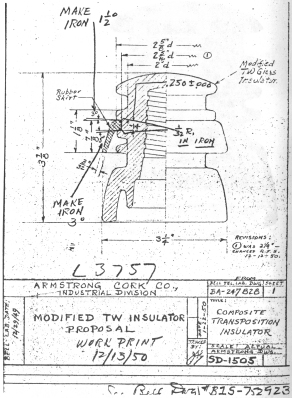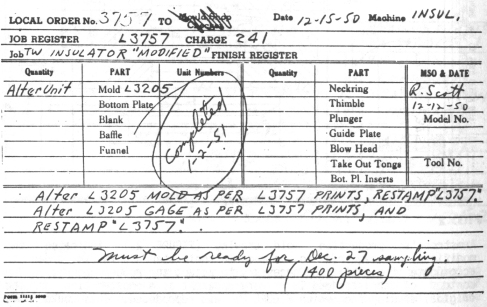Modified TW Composite Transposition Insulator
by Rich Wentzel
Reprinted from "Crown Jewels of the Wire", June 1987, page 21
Armstrong's CD 203.2 TW is unquestionably an elusive item. Information
recently made available from the archives of the Whitall Tatum-Armstrong-Kerr
glass insulator manufacturing department reveals that this insulator has not
been found in its intended configuration.
As can best be determined by the limited information that exists in regard to
this insulator, the CD 203.2 TW was an experimental unit developed along Bell
Laboratories' guidelines. Whether or not Bell was the intended client is
unknown. Work began on design development of the Armstrong designated
"Modified TW Composite Transposition Insulator" early in 1950. The
word "composite" is the key.

Photograph of CD 203.2
Front embossing is: Armstrong's T.W.
Rear embossing
is: Made in U.S.A. A in a circle

Fig. 1 Large Image (484 Kb)
FIGURE 1 indicates that the rings on the CD 203.2 TW were modified to accept
a rubber skirt. The corporate reasoning behind this type of dual-material
experimental insulator is no where to be found in the scant information
available.

Fig 2. Large Image (439 Kb)
Armstrong’s production mold drawing (FIGURE 2) indicates the modifications
required to be made to their standard TW in order to accommodate the extra ring
necessary to accept the rubber bonnet. The contour of the standard TW is very
apparent as a ghosted line on the original drawing from which FIGURE 2 was
reproduced. This contour has been dotted in here for clarity.
As to the number of units produced, Armstrong Mold Shop Order #3757, dated
12/12/50, (FIGURE 3) indicates that 1400 units were to be produced. Bear in
mind, however, that experimental designs underwent considerable testing - most
notably thermal shock testing which subjected insulators to immediate
temperature changes of 100 degrees Fahrenheit. This process invariably resulted
in the breakage of test specimens. Additionally, insulators were cut in half to
enable taking exact measurements at critical tolerance points. Information on
these processes is documented for many other types of Armstrong insulators, but
is unavailable for the CD 203.2 TW, making it impossible to speculate on the
number of units that survived intact.
Likewise, unfortunately, no information exists to verify the production of
the rubber skirts that were to be applied to this insulator.
This article summarizes the little remaining written data as pertaining to
Armstrong’s composite transposition insulator. Most of us, upon first seeing
the CD 203.2 modified TW, have no doubt wondered what purpose the extra ring
served. Now we know.

Fig 3. Large Image (279 Kb)
| 